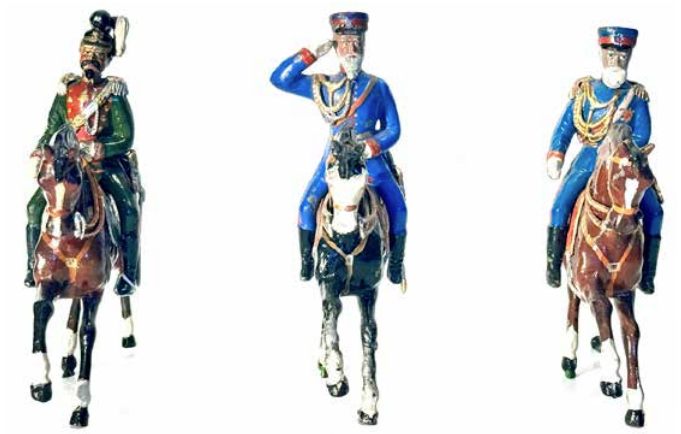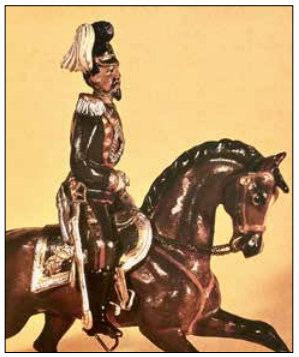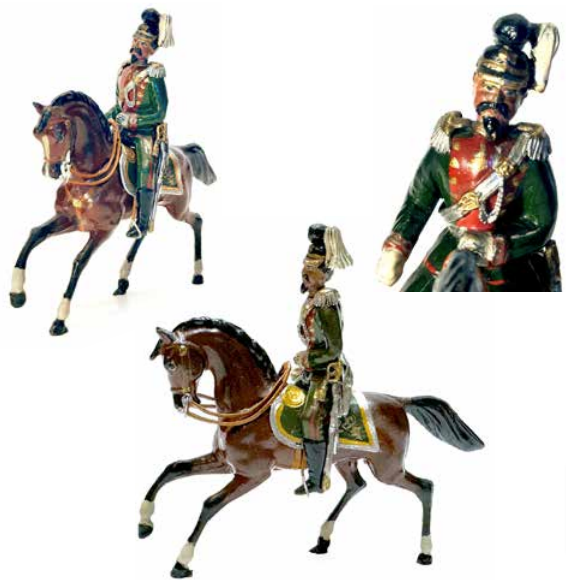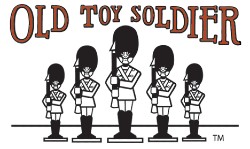Introduction
For several years now, I have had three old lead soldiers on horseback in my collection, which have now
given rise to this article. The figures are solid cast and very carefully decorated with many details. The
horses are very elaborately produced hollow casts, in which even the usual holes that arise when casting a hollow figure have been closed with metal. When the riders are mounted, they have a total height of 115 mm, (eye height, measured from the ground).

Perhaps the first figure in the green uniform looks familiar to you? This was featured in the 1981 book
“Bleisoldaten” (Lead Soldiers) by Dr. Hans-Henning Roer and is pictured on page 176. The description at the time was “Bavarian Army Leader” by Heyde. At that time, this figure, like the other two riders, was in the collection of Arthur Speyer. He was not only an excellent connoisseur of museum figures, but also inspired Roer’s first book.
More than 30 years ago, this book sparked many collectors to consider seriously the various manufacturers of fully round lead figures. Roer devoted himself to this scientific study from that point until his death. Personally, I was only marginally interested in the question of the manufacturer in those early years. I was primarily interested in the quality and design of the lead soldiers. This perspective changed over the years. Today, I am not only interested in who made the figures, but also (above all) in the historical perspective, i.e. which event or which people do they represent. Last but not least, I am also interested in the previous owners, in short, the provenance. So, a key question for me is: whose hands have the figures passed through? Do they have their own story?
Toys or Statues
Over the years I have also been able to buy figures directly from people who had played with them as children or who had received them from their father or grandfather. This meant that the figures were “real toys”. But what about such splendid large scale figures like these? Were children even allowed to play with them? The magnificent design of these three figures, their size (and the presumably very high price at the time they were purchased) speak against this. Nevertheless, I would not describe these types of figures as mere statuettes, not to be played with, but only to stand on the mantelpiece. It can be assumed that a potentate or even just a wealthy high-ranking officer also provided his sons with portrait figures of this size to play with. I have often heard from people who played with such old lead figures as children, that they only got hold of them under supervision and on special occasions.i This meant that they were well protected from damage.
Three Prince Regents

The three figures presented here are in wonderful original condition, apart from the horse reins of the rider, who is shown in the Roer book. In the book the figure has reins made of a chain. This same figure is now in my own collection. The reins have since been replaced with new ones, cast in tin. What is striking in the detailed illustration in the Roer book is that the rider is shown in mirror image. This is particularly noticeable due to the sabre, which in the photo in Roer’s book is shown on the right side of the rider. The sabre is always on the left so that it can be drawn with the right hand. This error occurred in the layout of the book due to incorrect use of the slide from which the image was taken.
Let us now consider this rider in his green uniform from a historical perspective. This, just like the other two riders, is a portrait figure. It depicts the Bavarian King Ludwig II in the uniform of his 4th Chevauxleger Regiment König, (Augsburg).ii Ludwig was born on August 25, 1845 and was later called the Fairy Tale King. He made a name for himself as a passionate builder of castles, especially the castles of Neuschwanstein, Herrenchiemsee and Linderhof. He was also a generous patron and supporter of Richard Wagner. His life was made into a great film in 1973 by Luchino Visconti with Helmut Berger as Ludwig II, Romy Schneider as Elisabeth of Austria and Trevor Howard as Richard Wagner.
The “German War of 1866”, also known as the Brothers’ War, took place during Ludwig’s reign. The Bavarians lost this war, fighting on the side of Austria against Prussia. This led to the eventual unification of Germany under Prussian leadership. Later in Ludwig’s reign (1870/1), Bavaria fought successfully on the side of Prussia against France in the Franco-Prussian war. As a result, in 1871, the German Empire was founded with the election of the German Emperor Wilhelm I, and the Second French Empire came to an end.
Ludwig II’s reign (as Regent of Bavaria) lasted from March 10, 1864 until his death on June 13, 1886. On that day, he died under mysterious circumstances in Lake Starnberg, together with the doctor who had prepared a psychiatric report on him. Based on this report, he was declared incapacitated shortly beforehand, on June 9, 1886. Because of this and his extravagance, he was declared unfit to hold office. In addition, his younger brother Otto was also declared unfit to govern due to mental illness.iii This led to his uncle, Luitpold of Bavaria, being appointed Prince Regent on June 10, 1886 at the age of 65. He has also been portrayed in lead.

Luitpold’s 26-year reign ended with his death on December 12, 1912. While his reign brought about a great cultural blossoming for Munich, for Bavaria it meant the gradual relegation of Bavarian interests to those of the German Empire led by Prussia. Luitpold supported social projects, he loved the mountains, and his great hobby was hunting.iv
Luitpold’s son Ludwig (at the age of 68) took over the reins of government, as the new Prince Regent in 1912, immediately after his father’s death. He was the last King of Bavaria, reigning as Ludwig III until November 7, 1918, for almost exactly 5 years. After the start of the First World War, the Bavarian army, which had previously sworn allegiance to the Bavarian king, was placed under the command of the German Emperor Wilhelm II. A few days after mobilization, Ludwig expressed that he expected the territorial expansion of Bavaria as a result of a victorious war… The eventual outcome of that terrible war and its consequences are of course now well known.v
Who made these figures?
Finally, let’s come to the important question of the manufacturer. The three figures are all solid cast with many fine details. The horses are very elaborately produced hollow castings in which even the usual holes, which arise when casting a hollow figure, have been closed up with metal. When the riders sit on their mounts they have a total height of 115 mm (to eye level, measured from the ground).
In his book “Bleisoldaten”, Roer attributes the figure to Georg Heyde. However, this and the other two figures are rather untypical for Heyde production in terms of posture and design. In my opinion Heyde is out of the question. However, I have not yet found any similar or identical figures of this size in their original packaging.
This leaves the door wide open for speculation.
The horses all appear to be based on identical castings. This suggests a common maker for all three
personalities. A notable feature is the small tufts of grass moulded on the hooves of the horses to help the figure stand.
Heyde was based in Dresden (Saxony). As the manufacturer of three different Bavarian Kings or Prince Regents, a Bavarian manufacturer would actually be more likely. Possible manufacturers based in Bavaria were, Johann Haffner, Nürnberg, Gebrüder Heinrich (Noris brand), based in Fürth, Christian Ammon (C.A.), based in Nuremberg and Johann Georg Heinrich (J.G.H), one of the Heinrich brothers who set up his own company in 1896.
J. Haffners Figures in similar size are completely different in style and therefore it is unlikely to be the maker. The company of Christian Ammon, represented by its owners Gebrüder Rothbarth, was taken over by Gebrüder Heinrich (with all its moulds) on February 15, 1910, and relocated to Fürth.vi There, production continued under the previous company name. This probably means that Ammon’s figures were always sold under the Ammon name. However, since we don’t have any original packaging for these figures, this is a hypothetical question.
A key figure that may provide a clue is Ludwig III, who was only a king from 1912 onwards, and thus a potentate who only fits into this series from that point in time onwards. In my opinion, this must mean that the production of this figure is after 1912 when the company C.Ammon was owned by the Heinrich brothers. If we look at the figure of Ludwig III in detail, it is noticeable that his reins are soldered on, (assuming of course that he is sitting on his original horse!). There is also no hole cast to put the reins through as is the case for the two earlier figures. These two personalities do not have reins soldered on, suggesting that they may have been made by Ammon who did not solder on reins.
Noris figures of this size always have the reins soldered on to the horses. However, so far, I have never come across horses with tufts of grass on their hooves, without a base, from any manufacturer, including Noris. Johann Georg Heinrich, the younger of the Heinrich brothers, who started his own business in 1896 under the brand name JGH, could also be a possible manufacturer.vii He produced many figures separately from his brothers, who continued to operate using the Noris brand name.
Johann could of course have come up with the idea of the tufts of grass on the hooves… but he died in 1907 and Ludwig III did not become king until 1912.
As is often the case, it is not easy to determine the manufacturer for certain. I think the most likely answer is that Heinrich brothers are the manufacturer of the third figure, probably using moulds
original produced by Ammon. This is primarily because of the horse’s head with the typical mane and the typical horse’s tail. Until someone discovers a rider with this typical horse, saddle blanket and rider in the original box with a different sticker than Gebrüder Heinrich, Noris brand or C. Ammon that remains my best guess.
Acknowledgement: Thanks to Martin Schabenstiel, without the important information he provided this article could not have been written.
End Notes:
i Swiss collector, Alfred Sulzer was allowed to play with ancient tin figures owned by his family from the age of just 5! Although he describes this today as a crime, it triggered his love for museum quality figures (see: Mikrowelten Zinnfiguren, Germanisches Nationalmuseum 2024, page 17).
ii For all three riders, Martin Schabenstiel provided valuable advice regarding the uniforms and the identification of these three equestrian personalities.
iii Wikipedia König Ludwig II. (Bayern).
iv Wikipedia Luitpold von Bayern.
v Wikipedia – Ludwig III. (Bayern).
vi www.zinnfiguren-bleifiguren.com – Gebrüder Heinrich.
vii www.zinnfiguren-bleisoldaten.com – Gebrüder Heinrich.
